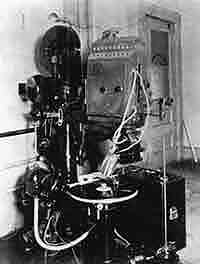‘Don Juan’ was a test production to show off the capabilities of the Vitaphone System.
The era of silent movies was at an end, the ability for the actors to speak was a huge advancement in sound of that time. Many film producers did not believe the idea of using speech was a good thing as for twenty or so years the public had been used to silent movies with no speech. The first film to be released to a audience as a test was Warner Bros ‘The Jazz Singer’ with Al Johnson. It was a musical film that contained dancing, singing and dramatic and most importantly synchronised sound.
 The Jazz Singer (1927) was the first time the Warner Bros. Vitaphone system was used to combine the sound and film in synchronisation. This new technology was a major up step in sound as it enabled the use of voice to be heard on screen! The sound was pressed onto disk lathes that would play the sound as soon as the video started. This enabled the use of recorded sound rather than for instance hiring a orchestra to play every time the movie was screened. This made a lot of theatre musicians out of work, the era of live music for film was starting to dissipate. The combining of film and sound in synch was a positive step forward however they still had a few issues when having both the orchestra within the same confines of the film set.
The Jazz Singer (1927) was the first time the Warner Bros. Vitaphone system was used to combine the sound and film in synchronisation. This new technology was a major up step in sound as it enabled the use of voice to be heard on screen! The sound was pressed onto disk lathes that would play the sound as soon as the video started. This enabled the use of recorded sound rather than for instance hiring a orchestra to play every time the movie was screened. This made a lot of theatre musicians out of work, the era of live music for film was starting to dissipate. The combining of film and sound in synch was a positive step forward however they still had a few issues when having both the orchestra within the same confines of the film set.
With the sucess of the Jazz singer it was not long till a few years later in 1932 the technology to “over – dub” was brought into the film production system. The overdubb advancement gave film makers the change to add music where they wanted at a later date, having a seperate recording overdubb studio to do sound effects, vocal over dubs and musical scoring on top of the film. A selection of only four channels to record onto for which to layer these various elements.This meant that in some cases such people had to lip sync even orchestras! This was the case with a lot of their performances within a film environment often to a playback system within the film studio. For the first time music could be separately recorded, giving the composer edge and broadening how music would change in sync with the emotional dynamics of a given film.
n/a. (2005). 1920’s Movies. Available: http://www.1920-30.com/movies/. Last accessed 1/1/2011.
Allan, Bob. (n/a). 70 Years Of Synch Sound. Available: http://www.amps.net/newsletters/issue19/19_synch.htm. Last accessed 1/1/2011.
Wainwright, Stephen R. (2006-2010). The Story of Oscar-Winning, Movie Sound Pioneer GEORGE R. GROVES. Available: http://www.georgegroves.org.uk/belllabs.html. Last accessed 1/1/2011.


